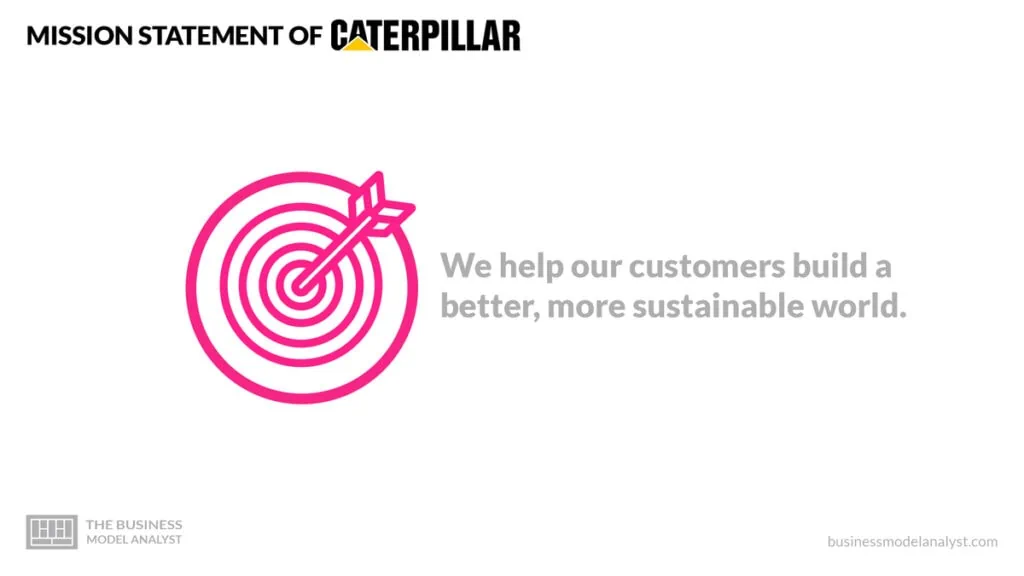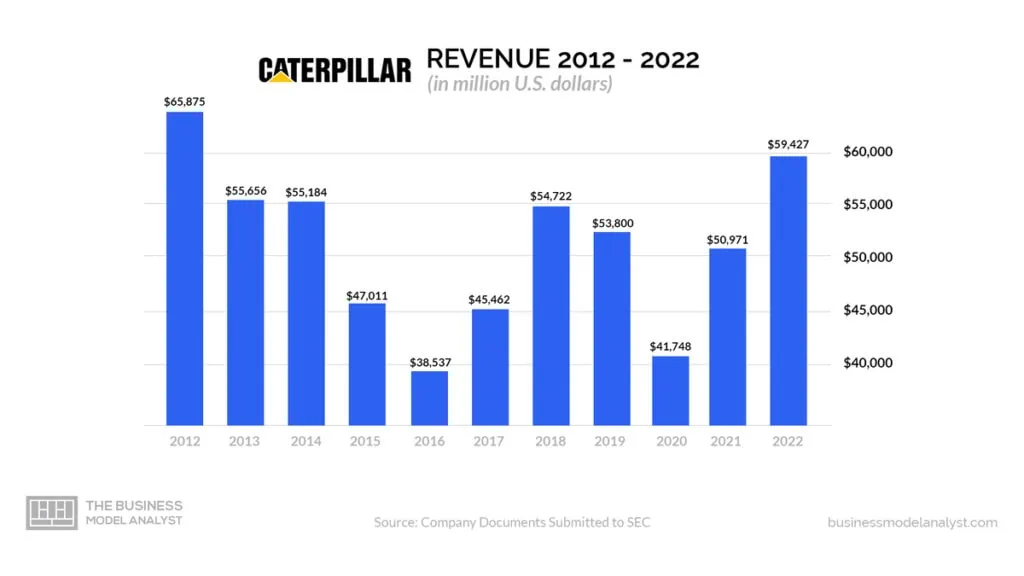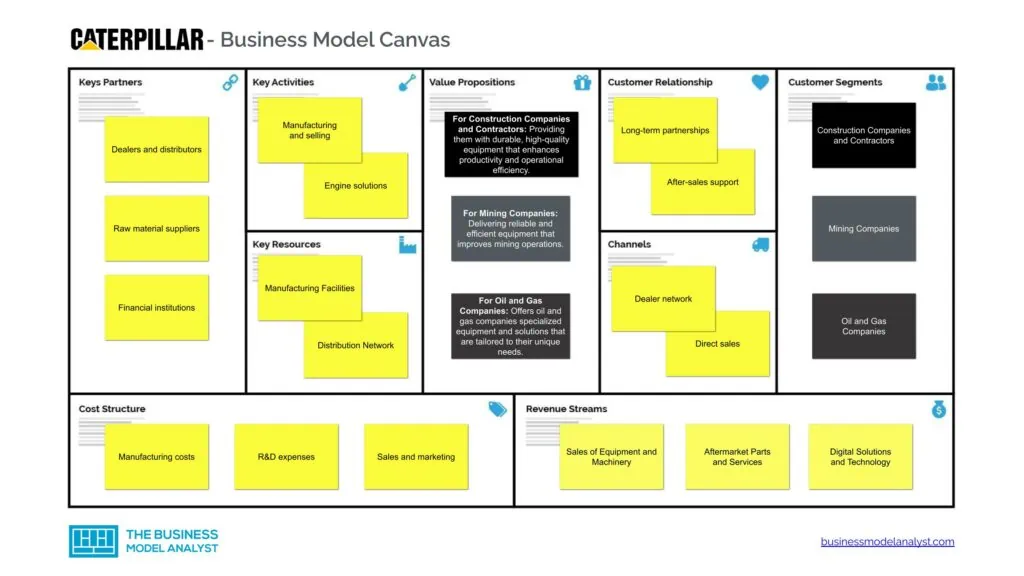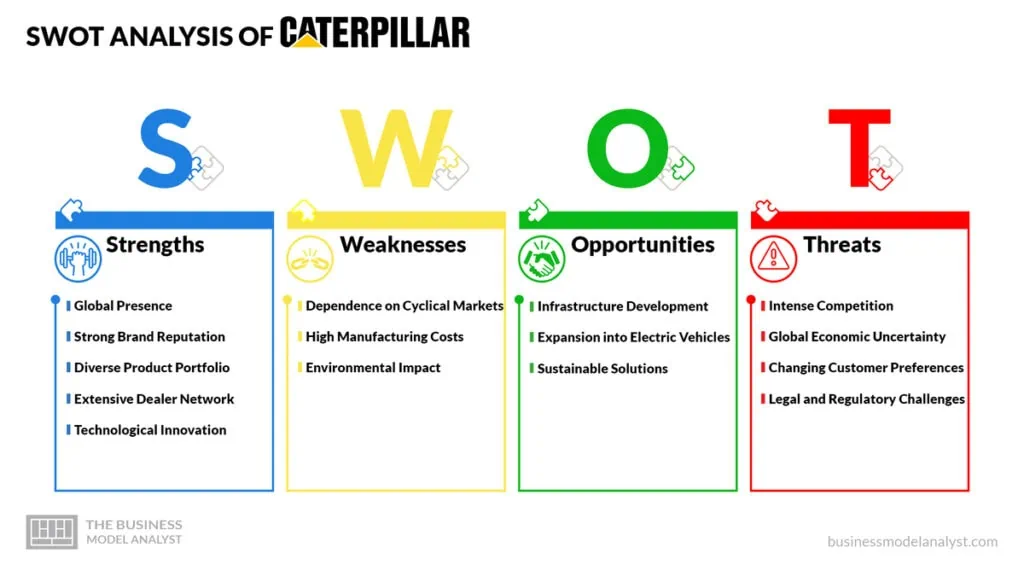The Caterpillar business model is built on innovation, quality, and a deep understanding of customer needs. Through its extensive product portfolio, including brands like CAT, Perkins, and Solar Turbines, Caterpillar caters to various industries, including construction, mining, energy, transportation, and manufacturing.
Caterpillar, also known as CAT, is a global leader in the manufacturing and selling of construction and mining equipment, diesel and natural gas engines, industrial gas turbines, and other related products and services. With a rich history dating back to 1925, Caterpillar has solidified its position as a trusted provider of heavy machinery solutions for various industries.
With a mission to enable sustainable progress for its customers and communities, Caterpillar focuses on delivering superior products and services while promoting environmental responsibility and social impact. By investing in research and development, Caterpillar continually pushes the boundaries of technology, creating innovative solutions that enhance efficiency, productivity, and safety.

Contents
A brief history of Caterpillar
Caterpillar, a globally recognized name in the construction and mining equipment industry, has a rich history that dates back over a century. The company’s origins can be traced back to 1925, when two separate companies, Holt Manufacturing Company and C. L. Best Tractor Co., merged to form Caterpillar Tractor Co.
Holt Manufacturing Company, founded by Benjamin Holt in 1883, was known for its innovative use of continuous tracks on agricultural tractors, which greatly improved their performance and traction. Meanwhile, C. L. Best Tractor Co., established by Charles L. Best in 1910, was also a prominent player in the tractor industry, focusing on developing efficient and reliable machines.
The merger of these two companies created a powerhouse in the industry, combining their expertise and resources to meet the growing demand for heavy equipment. The newly formed Caterpillar Tractor Co. quickly gained a reputation for producing high-quality, durable tractors that could withstand the tough conditions of construction and mining sites.
Over the years, Caterpillar continued to expand its product offerings, introducing a wide range of equipment for various industries, including construction, mining, forestry, and energy. The company’s commitment to innovation and technological advancements played a significant role in its success, as it continuously developed new and improved machinery to meet the evolving needs of its customers.
Throughout its history, Caterpillar also made strategic acquisitions and partnerships to strengthen its position in the market. These acquisitions allowed the company to broaden its product portfolio, expand its global footprint, and tap into new growth opportunities. Notable acquisitions include the purchase of Bucyrus International, a leading mining equipment manufacturer, in 2011, and the acquisition of Weir Oil & Gas, an oil and gas equipment manufacturer, in 2021.
Caterpillar’s business model has remained resilient over the years, focusing on providing reliable and durable equipment, backed by a strong support network of dealers and service providers. The company’s commitment to customer satisfaction and its ability to adapt to changing market conditions have played a crucial role in its longevity and continued success.
Today, Caterpillar stands as a global leader in the construction and mining equipment industry, with a presence in more than 180 countries. The company’s dedication to innovation, sustainability, and helping customers build a better world remains at the core of its business model. As Caterpillar continues to evolve and embrace new technologies, it remains a trusted partner for industries worldwide, driving progress and shaping the future of construction and mining.
Who Owns Caterpillar
According to CNN Money, as of 6th December 2023, institutional investors collectively control a dominant 71.37% of Caterpillar Inc.’s outstanding shares, showcasing a level of interest that surpasses industry norms.
This can be broken down into the following: Mutual fund holders contribute to 36.37% of this ownership, while other institutional investors account for an additional 35.00%. Individual stakeholders hold a comparatively smaller stake of 1.15%.
Top 10 Shareholders
- The Vanguard Group, Inc. (9.03%):
The Vanguard Group, Inc. is a renowned investment management company headquartered in Pennsylvania, USA. It is one of the largest and most influential asset management firms globally. The Vanguard Group holds a substantial 9.03% stake in Caterpillar Inc., equivalent to 46,068,853 shares, with a total market value of $10,413,864,221.
- SSgA Funds Management, Inc. (7.38%):
State Street Global Advisors (SSgA) is a prominent asset management company and a subsidiary of State Street Corporation. It is known for its wide range of investment strategies and solutions. SSgA Funds Management, Inc. closely follows as the second-largest shareholder with a 7.38% stake, representing 37,624,509 shares valued at $8,505,020,259.
- Capital Research & Management Co. (5.67%):
Capital Research & Management Co. is a leading investment management firm with a history of successful long-term investments. The company is known for its research-driven approach to portfolio management. Holding 5.67% of Caterpillar Inc., Capital Research & Management Co. possesses 28,933,474 shares, valued at $6,540,411,798.
- BlackRock Fund Advisors (4.39%):
BlackRock Fund Advisors is a key subsidiary of BlackRock, Inc., the world’s largest asset manager. BlackRock is known for its diverse range of investment products and global presence. BlackRock Fund Advisors owns 4.39% of Caterpillar, representing 22,388,616 shares valued at $5,060,946,647.
- State Farm Investment Management (3.48%):
State Farm Investment Management is part of the State Farm insurance group and manages investments on behalf of the insurance company. It is recognized for its disciplined investment approach. State Farm Investment Management holds a 3.48% stake, owning 17,761,276 shares valued at $4,014,936,440.
- Geode Capital Management LLC (1.89%):
Geode Capital Management LLC is a Boston-based investment management firm that specializes in quantitative analysis and research-driven investment strategies. Geode Capital Management holds a 1.89% stake, equivalent to 9,654,207 shares, with a total market value of $2,182,333,492.
- Fisher Asset Management LLC (1.56%):
Fisher Asset Management LLC, founded by Ken Fisher, is an independent investment advisory firm known for its global perspective and contrarian approach to investing. Fisher Asset Management owns a 1.56% stake, represented by 7,965,932 shares valued at $1,800,698,929.
- Bill & Melinda Gates Foundation Trust (1.44%):
The Bill & Melinda Gates Foundation Trust manages the endowment assets of the Bill & Melinda Gates Foundation. The trust focuses on long-term investments to support the foundation’s philanthropic initiatives. Holding a 1.44% stake, the trust owns 7,353,614 shares, with a total market value of $1,662,284,445.
- Northern Trust Investments, Inc. (1.23%):
Northern Trust Investments, Inc. is a subsidiary of Northern Trust Corporation, providing investment management and wealth management services globally. With a 1.23% stake, Northern Trust Investments, Inc. owns 6,284,941 shares, valued at $1,420,710,913.
- Norges Bank Investment Management (0.96%):
Norges Bank Investment Management is the asset management arm of the Norwegian central bank, responsible for managing the Government Pension Fund Global, one of the largest sovereign wealth funds globally. Norges Bank Investment Management holds a 0.96% stake, comprising 4,905,890 shares, with a total market value of $1,108,976,435.
Caterpillar Mission Statement
Caterpillar’s mission statement is “We Help Our Customers Build A Better, More Sustainable World.”

How Caterpillar works
Caterpillar’s business model revolves around offering a comprehensive range of products and services to meet the diverse needs of its customers. The company provides equipment and machinery for various sectors, including construction, mining, energy, and transportation. Caterpillar’s product portfolio includes excavators, bulldozers, loaders, generators, and engines.
Customers can engage with the company through various channels to access Caterpillar’s products and services. One option is to purchase equipment directly from Caterpillar dealerships worldwide. These dealerships provide customers with a wide selection of products and access to knowledgeable sales representatives who can assist in finding the right equipment for their specific needs.
Caterpillar also offers online purchasing options, allowing customers to browse and buy products through the company’s official website. This digital platform provides a convenient and efficient way for customers to explore Caterpillar’s product offerings, compare models, and make informed purchases.
Caterpillar’s commitment to customer satisfaction extends beyond just selling equipment. The company also provides comprehensive after-sales services to help customers maximize the performance and lifespan of their equipment. This includes maintenance and repair services, equipment monitoring and diagnostics, as well as training programs to ensure that customers can operate their equipment safely and efficiently.
In line with the growing demand for sustainable solutions, Caterpillar has also strongly emphasized incorporating innovative technologies into its products. This includes integrating advanced telematics systems and data analytics, which enable customers to monitor and optimize the performance of their equipment, improve fuel efficiency, and reduce downtime.
Furthermore, Caterpillar has embraced the circular economy concept by offering remanufactured parts and components. This reduces waste and extends the life cycle of equipment, providing a cost-effective and environmentally friendly alternative to purchasing new parts.
How Caterpillar makes money
Caterpillar operates a diversified business model that generates revenue through various streams. The following are the primary ways through which Caterpillar makes money:

Sales of Equipment and Machinery
Caterpillar is known for its extensive range of construction and mining equipment, engines, and power systems. The company generates a significant portion of its revenue from the sale of these products. Its customers include construction companies, mining companies, and other industries that rely on heavy machinery for their operations. Caterpillar offers a wide range of equipment, including excavators, bulldozers, wheel loaders, backhoe loaders, and generators.
Caterpillar also provides equipment financing solutions to its customers, allowing them to purchase its products through financing options. This enables customers to acquire the necessary machinery while reducing costs over time.
Aftermarket Parts and Services
Once Caterpillar sells its equipment, it continues to generate revenue by selling aftermarket parts and services. Caterpillar’s extensive network of dealers and distributors ensures that customers have access to genuine Caterpillar parts, ensuring their equipment’s performance, reliability, and longevity. The company also offers maintenance and repair services, equipment rental, and training programs to assist customers in optimizing the performance and uptime of their equipment.
Digital Solutions and Technology
Caterpillar has embraced digital transformation in its business model, offering a range of digital solutions and technology-enabled services. These include telematics systems that collect and analyze machine data, allowing customers to remotely monitor and manage their equipment. Caterpillar also offers predictive maintenance solutions that help customers identify potential equipment failures before they occur, reducing downtime and improving productivity.
Additionally, Caterpillar provides software and analytics platforms that enable customers to optimize their operations, improve efficiency, and reduce costs. These digital solutions offer valuable insights into equipment performance, fuel consumption, operator behavior, and overall productivity.
Rental and Used Equipment
In addition to selling new equipment, Caterpillar generates revenue by renting and selling used equipment. The company offers rental options for customers who require equipment for temporary projects or short-term needs. This allows customers to access Caterpillar’s high-quality equipment without the upfront cost of purchasing.
Caterpillar also sells used equipment that has been returned from rental or is no longer needed by customers. These used equipment sales provide an additional revenue stream for the company.
Caterpillar Business Model Canvas
The Caterpillar Business Model can be explained in the following business model canvas:

Caterpillar Customer Segments
Caterpillar serves a diverse range of customer segments. These segments consist of:
- Construction Companies and Contractors: Caterpillar’s primary customer segment includes construction companies and contractors worldwide. These businesses rely on Caterpillar’s equipment to conduct construction projects efficiently and effectively. Whether excavators, bulldozers, or loaders, Caterpillar provides a wide range of equipment options to meet the specific needs of construction projects;
- Mining Companies: Another significant customer segment for Caterpillar is mining companies. The mining industry heavily relies on heavy machinery to extract valuable resources from the earth. Caterpillar’s equipment, such as mining trucks, hydraulic shovels, and drill rigs, play a vital role in increasing productivity and reducing operational costs for mining companies;
- Oil and Gas Companies: Caterpillar caters to the needs of oil and gas companies, offering specialized equipment and solutions for exploration, production, and transportation in the sector. Its extensive product range includes well-stimulation pumps, generators, and gas compression systems, providing reliable and efficient solutions for the oil and gas industry;
- Infrastructure Development Authorities: Caterpillar supplies equipment and machinery to government agencies and authorities responsible for infrastructure development. Whether it’s road construction, bridges, or irrigation projects, Caterpillar’s customers in this segment rely on its equipment to meet the demands of infrastructure development projects;
- Rental Companies: Caterpillar also serves rental companies that provide machinery and equipment on a short-term basis. These companies often choose Caterpillar products for their durability, reliability, and low maintenance costs. Providing equipment to rental companies allows Caterpillar to reach a broader customer base and expand its market presence;
- Agriculture and Forestry: Caterpillar offers a range of agricultural and forestry equipment to meet the needs of farmers, ranchers, and forestry companies. From tractors and combines to skidders and log loaders, Caterpillar’s products help optimize productivity and minimize downtime in these industries;
- Government and Defense: Caterpillar provides equipment and solutions to government agencies and defense organizations worldwide. These customers rely on Caterpillar for various applications, including border security, disaster response, and military operations;
- Others: Besides the above customer segments, Caterpillar serves various other industries such as utilities, industrial manufacturing, and material handling. These industries benefit from Caterpillar’s specialized equipment and solutions tailored to their specific operational requirements.
Caterpillar’s customer segments span different industries and sectors, making it a versatile equipment and solutions provider.
Caterpillar Value Propositions
Caterpillar’s value propositions consist of:
- For Construction Companies and Contractors: Caterpillar’s value proposition for construction companies and contractors is centered around providing them with durable, high-quality equipment that enhances productivity and operational efficiency. They offer a wide range of machinery, including excavators, bulldozers, and loaders, equipped with advanced technology and innovative features;
- For Mining Companies: For mining companies, Caterpillar’s value proposition lies in delivering reliable and efficient equipment that improves mining operations. Their mining trucks, hydraulic shovels, and drill rigs are designed to handle the challenges of the mining environment, enhancing productivity and reducing costs. Caterpillar’s advanced technology and telematics systems enable mining companies to monitor and optimize their equipment performance, ensuring maximum uptime and fuel efficiency;
- For Oil and Gas Companies: Caterpillar offers oil and gas companies specialized equipment and solutions that are tailored to their unique needs. Their value proposition includes providing reliable and efficient equipment for exploration, production, and transportation in the oil and gas industry. Caterpillar’s well-stimulation pumps, generators, and gas compression systems are designed to deliver optimal performance and reliability in harsh and remote environments;
- For Infrastructure Development Authorities: Caterpillar’s value proposition to infrastructure development authorities focuses on providing reliable and durable equipment to support their projects. Their range of construction machinery, such as road graders, compactors, and pavers, enables these authorities to develop infrastructure efficiently and precisely;
- For Rental Companies: For rental companies, Caterpillar’s value proposition lies in providing them with equipment that delivers exceptional performance and reliability during short-term rentals. Their products, known for their durability and low maintenance costs, allow rental companies to offer their customers high-quality machinery that enhances their operational capabilities. Caterpillar’s global dealer network ensures prompt service and support, including spare parts availability and comprehensive maintenance programs;
- For Agriculture and Forestry: Caterpillar’s value proposition to the agriculture and forestry sectors revolves around providing durable, efficient, and technologically advanced equipment. Their tractors, harvesters, and forestry machinery are designed to improve productivity, reduce operating costs, and minimize environmental impact. Caterpillar offers precision farming solutions, such as GPS guidance systems and telematics, to optimize crop yields and resource utilization;
- For Government and Defense: Caterpillar’s value proposition to government agencies and defense organizations lies in providing them with specialized equipment and solutions for various applications. Their border security systems, disaster response equipment, and military vehicles are designed to meet the specific needs of these sectors. Caterpillar’s value proposition includes reliable performance, durability, and adaptability to different operational environments;
- For Others: For customers in industries such as utilities, industrial manufacturing, and material handling, Caterpillar’s value proposition includes providing them with a wide range of specialized equipment and solutions. Their products are designed to deliver high performance, reliability, and efficiency in these applications. Caterpillar offers tailored financing options, flexible maintenance contracts, and comprehensive training to meet the specific needs of each industry.
Caterpillar Channels
Caterpillar’s channels consist of:
- Dealer network: Caterpillar relies on a well-established global network of independent dealers to distribute its products, providing customers with local access to sales, service, and support;
- Direct sales: Caterpillar also engages in direct sales with large customers, including governments, multinational corporations, and organizations that require specialized equipment for their operations;
- E-commerce: As part of its digital strategy, Caterpillar operates an online platform where customers can access product information, place orders, and manage their accounts.
Caterpillar Customer Relationships
Caterpillar’s customer relationships consist of:
- Long-term partnerships: Caterpillar builds strong customer relationships by establishing long-term partnerships. It works closely with customers to understand their specific requirements and provide tailored solutions;
- After-sales support: Caterpillar significantly emphasizes after-sales service, offering maintenance, repair, and spare parts to ensure customer satisfaction and retention;
- Training and consultation: Caterpillar provides training and consultation services to customers, helping them optimize the use of their equipment and achieve maximum efficiency.
Caterpillar Revenue Streams
Caterpillar’s revenue streams consist of:
- Sales of Equipment and Machinery
- Aftermarket Parts and Services
- Digital Solutions and Technology
- Rental and Used Equipment
Caterpillar Key Resources
Caterpillar’s key resources consist of:
- Manufacturing Facilities: Caterpillar operates numerous manufacturing facilities worldwide, producing an extensive range of equipment to meet customer demand;
- Distribution Network: The company’s vast global network of dealers ensures efficient product distribution, localized sales, and after-sales support;
- Technological Expertise: Caterpillar invests heavily in research and development to maintain a competitive edge and offer innovative solutions, leveraging its technological expertise to improve product performance and efficiency;
- Brand Reputation: Caterpillar’s strong brand reputation, built over many decades, provides a competitive advantage, instilling trust and confidence in its customers;
- Skilled Workforce: The company’s skilled workforce, including engineers, technicians, and sales professionals, is vital in delivering high-quality products and superior customer service.
Caterpillar Key Activities
Caterpillar’s key activities consist of:
- Manufacturing and selling
- Engine solutions
- Rental services
- Innovation and technology
- Research and development
- Training and support
Caterpillar Key Partners
Caterpillar’s key partners consist of:
- Dealers and distributors
- Raw material suppliers
- Financial institutions
- Governments and regulators
- Research institutions
- Industry associations
Caterpillar Cost Structure
Caterpillar’s cost structure consists of:
- Manufacturing costs
- R&D expenses
- Sales and marketing
- Distribution and logistics
- Administrative costs
- Employee expenses
Caterpillar Competitors
Here are some of Caterpillar’s primary competitors:
- Komatsu: A Japanese multinational corporation, Komatsu is recognized for its reliable construction and mining equipment. It has a strong presence in Asia and is known for its technologically advanced machinery;
- Volvo: Volvo Construction Equipment, a subsidiary of the Swedish automaker, offers a diverse range of heavy machinery and construction equipment. Volvo is particularly known for its innovative solutions and commitment to sustainability;
- John Deere: Although primarily associated with agricultural machinery, John Deere also competes with Caterpillar in the construction and forestry sectors. John Deere benefits from its strong brand reputation and extensive distribution network;
- Hitachi Construction Machinery: This Japanese company specializes in manufacturing construction and mining equipment. Hitachi is notable for its advanced technological features and efficient machinery;
- Liebherr: Liebherr is a family-owned company based in Germany, offering a wide variety of construction machinery and mining equipment. Its products are often recognized for their quality, durability, and precision;
- Atlas Copco: A Swedish industrial company, Atlas Copco focuses on providing solutions for the construction, mining, and oil industries. It is known for its high-quality compressors, generators, and innovative mining equipment.
Caterpillar SWOT Analysis
By examining Caterpillar’s strengths, weaknesses, opportunities, and threats, we can understand the company’s business model and its ability to navigate through favorable and challenging market conditions.

Caterpillar Strengths
- Global Presence: Caterpillar operates in over 180 countries, giving it significant reach and market share;
- Strong Brand Reputation: Caterpillar is a trusted and well-known brand in the heavy machinery industry, associated with quality and reliability;
- Diverse Product Portfolio: Caterpillar offers a wide range of products, including construction, mining, and power equipment, providing a competitive advantage;
- Extensive Dealer Network: Caterpillar has a strong network of authorized dealers worldwide, enabling widespread distribution and customer support;
- Technological Innovation: Caterpillar invests heavily in research and development, resulting in innovative products and technologies that improve efficiency and productivity.
Caterpillar Weaknesses
- Dependence on Cyclical Markets: Caterpillar’s business is highly cyclical and vulnerable to economic downturns, impacting its sales and profitability;
- High Manufacturing Costs: Caterpillar’s heavy machinery manufacturing requires a significant amount of capital, making it exposed to fluctuations in production costs;
- Environmental Impact: The company faces criticism regarding the environmental impact of its products, particularly in terms of carbon emissions and resource consumption.
Caterpillar Opportunities
- Infrastructure Development: The need for infrastructure development, particularly in emerging markets, presents growth opportunities for Caterpillar’s construction equipment segment;
- Expansion into Electric Vehicles: The growing demand for electric vehicles creates an opportunity for Caterpillar to diversify its product range and enter the market with eco-friendly offerings;
- Sustainable Solutions: As sustainability becomes a priority for businesses globally, Caterpillar has the opportunity to develop products and services that align with the growing demand for environmentally friendly and energy-efficient solutions.
Caterpillar Threats
- Intense Competition: Caterpillar faces competition from both established players and emerging companies in the heavy machinery industry, increasing pressure on market share and pricing;
- Global Economic Uncertainty: Economic instability, trade disputes, and geopolitical tensions create uncertainty that can impact Caterpillar’s sales and profitability;
- Changing Customer Preferences: Shifting customer preferences, including the adoption of alternative energy sources and digital technologies, may require Caterpillar to adapt its product offerings;
- Legal and Regulatory Challenges: Caterpillar operates in multiple jurisdictions and is subject to various regulations and legal risks, including compliance with emission standards and workplace safety regulations.
Conclusion
Caterpillar’s business model is a well-established and successful approach to the heavy machinery industry. The company demonstrates a strong commitment to innovation, customer satisfaction, and sustainability, which have allowed them to maintain a competitive advantage in the market.
By focusing on a diverse range of products, services, and rental options, Caterpillar has successfully adapted to changing customer needs and market conditions. Additionally, their global footprint and extensive dealer network have facilitated expansion into new markets, further enhancing their growth potential.
Caterpillar’s strategic focus on delivering superior value to customers and stakeholders, coupled with their operational excellence, position them as a market leader in the heavy machinery sector.

